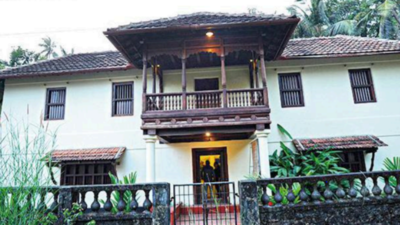- News
- City News
- bengaluru News
- Karnataka: Experts propose measures to preserve architecture of Kodagu & Tulunadu
Trending
This story is from December 19, 2021
Karnataka: Experts propose measures to preserve architecture of Kodagu & Tulunadu
Picturesque old Guthu houses with beautiful chaavadis, spacious courtyards drenched in rain, thick pillars and woodwork-heavy doors, small kitchens that open into dining areas and the attached sacred spaces — the ancestral houses of Tulunadu enchanted all on Saturday even as architects

Traditional Guthu houses have become rare and they need to be conserved, say experts
Bengaluru: Picturesque old Guthu houses with beautiful chaavadis, spacious courtyards drenched in rain, thick pillars and woodwork-heavy doors, small kitchens that open into dining areas and the attached sacred spaces — the ancestral houses of Tulunadu enchanted all on Saturday even as architects and academicians discussed their poor state now.
During a discussion on the independent houses and forest shrines of Kodagu, Brinda Somaya, an architect and urban conservationist, lamented the irreversible loss of several architectural marvels in Kodagu.Attributing it to migration, harsh weather conditions and building maintenance difficulties, she stressed the need for documentation and living in harmony with nature.
“Every part of these buildings, including choice of materials, construction methodology, patterns of building activity, spatial organisation and ritual meaning assigned to various aspects, reflects the governing principles of a highly organised and hierarchical traditional society,” said Somaya.
From patrilinear joint families, the session moved on to Tulunadu, where a matrilinear setup was in place. But the reasons for the loss of heritage structures were identified to be similar. “There are hundreds of homes that are more than hundreds of years old. But many of them are in a sad state. With lifestyle changes and people moving to cities, many are not interested in them and the cost of maintenance is high. A few structures are retained because of their cultural significance,” said Gayathri Shetty, an architect involved in an upcoming publication on the building techniques of Dakshina Kannada.
“There is a need to develop a system of joint ownerships and trusts as the generations in the homes now come up to 80-120 members. We need to ensure that the structure is not sacrificed in the bargaining between members. These homes can also become areas to revive local arts,” she said.
Sayeegeetha Hegde, a Tulu linguistic scholar, said: “There was a time when 80 people used to stay here. It is not just about the family, but an entire village and its heritage.”
From memories of staying at the Kodagu homes to catching fish from paddy fields to watching elders lie down on a wooden bench attached to the window to supervise workers on the field, the architects shared nostalgic snippets during the session, held as part of Bangalore Literature Festival.
During a discussion on the independent houses and forest shrines of Kodagu, Brinda Somaya, an architect and urban conservationist, lamented the irreversible loss of several architectural marvels in Kodagu.Attributing it to migration, harsh weather conditions and building maintenance difficulties, she stressed the need for documentation and living in harmony with nature.
“Every part of these buildings, including choice of materials, construction methodology, patterns of building activity, spatial organisation and ritual meaning assigned to various aspects, reflects the governing principles of a highly organised and hierarchical traditional society,” said Somaya.
From patrilinear joint families, the session moved on to Tulunadu, where a matrilinear setup was in place. But the reasons for the loss of heritage structures were identified to be similar. “There are hundreds of homes that are more than hundreds of years old. But many of them are in a sad state. With lifestyle changes and people moving to cities, many are not interested in them and the cost of maintenance is high. A few structures are retained because of their cultural significance,” said Gayathri Shetty, an architect involved in an upcoming publication on the building techniques of Dakshina Kannada.
The ideas include turning them into hospitality projects. “Some of them can be as big as those that have 80 rooms. The courtyard can be further divided into various portions for functions such as weddings. This will bring in income that can be used for maintenance,” she said.
“There is a need to develop a system of joint ownerships and trusts as the generations in the homes now come up to 80-120 members. We need to ensure that the structure is not sacrificed in the bargaining between members. These homes can also become areas to revive local arts,” she said.
Sayeegeetha Hegde, a Tulu linguistic scholar, said: “There was a time when 80 people used to stay here. It is not just about the family, but an entire village and its heritage.”
From memories of staying at the Kodagu homes to catching fish from paddy fields to watching elders lie down on a wooden bench attached to the window to supervise workers on the field, the architects shared nostalgic snippets during the session, held as part of Bangalore Literature Festival.
End of Article
FOLLOW US ON SOCIAL MEDIA










